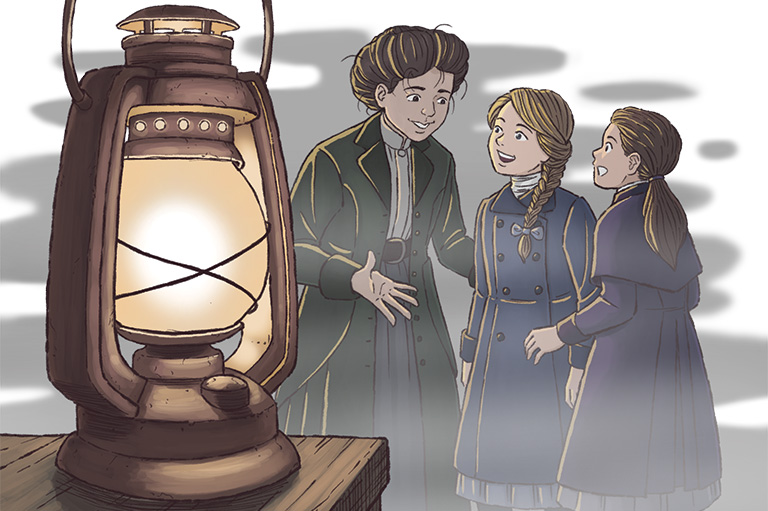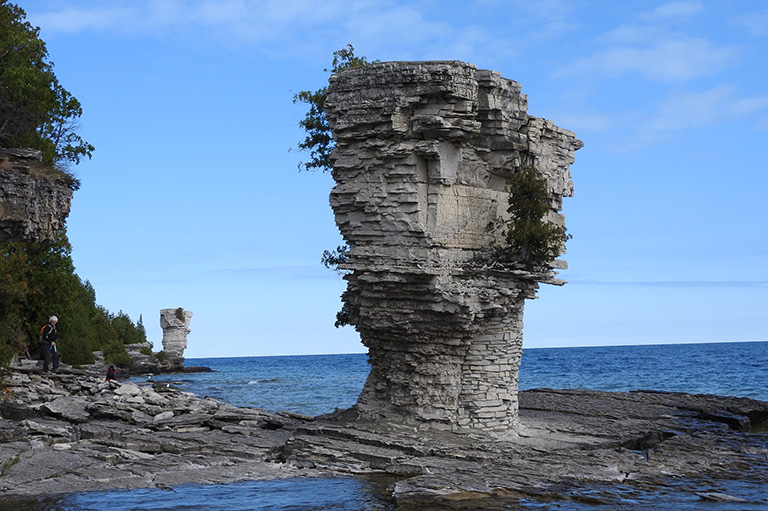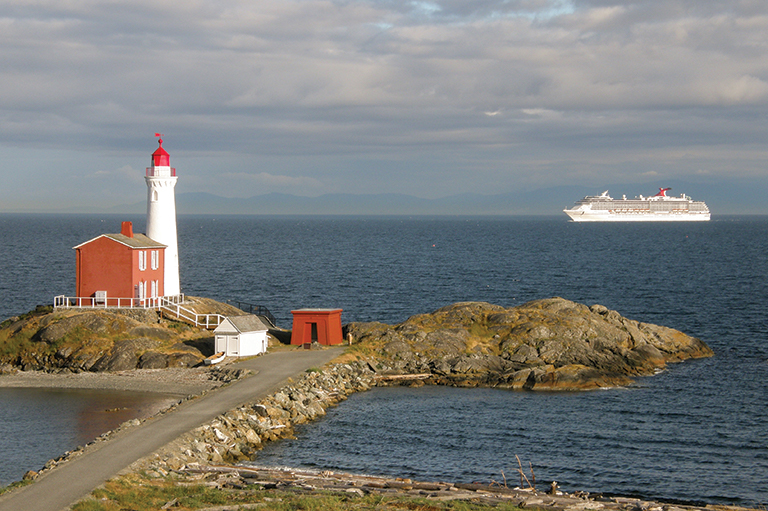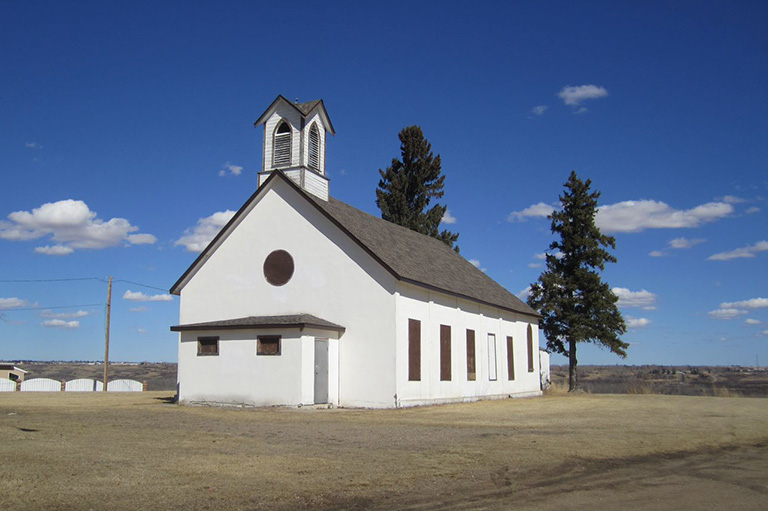Beacons Through Time
The lighthouses of centuries past probably never needed to be quite so beautiful. How fortunate it is that so many were built with elegance as well as practicality in mind. And how much more mundane our maritime landscapes would be without them. Where their modern equivalents are soulless beacons atop workaday steel skeletons, historical lighthouses evoke delight. These loveliest of landmarks often have a story to tell. Here are just a few.
Rose Blanche, Newfoundland and Labrador
In July 1828, the Irish immigrant ship Despatch wrecked on the rocks off Isle aux Morts, a small town on Newfoundland’s southwest coast. Despite the terrible storm, seventeen-year-old Ann Harvey, along with her father, brother, and their Newfoundland dog, Hairyman, rescued 163 people over three days. Forty-eight others were lost. After residents petitioned the House of Assembly, the government built several sturdy lighthouses along that stretch of coast.
The Rose Blanche structure, which began operating in 1873, is one of the last remaining granite lighthouses on the island. The original light was decommissioned and replaced with an automated signal in the 1940s. By the 1980s, only the lighthouse’s tower was still standing; but community groups, supported by federal funding, restored the entire building by 1999. The original granite blocks were reused where possible, and supplemental blocks were quarried, using traditional methods, from the same site as the originals.
Illumination comes from a light housed inside a rare 43.3-centimetre-high Fresnel lens, believed to be one of only twenty-seven of its kind left in existence. The lens designs of French physicist Augustine Fresnel revolutionized lighthouses in the nineteenth century with their innovative use of reflection and refraction to focus the light beam, making it visible from extremely long distances. The former keeper’s quarters are now a museum.
With 7 uniquely curated newsletters to choose from, we have something for everyone.
Triple Islands, B.C.
This fortress-like lighthouse and its keeper’s quarters stand alone, exposed on a rocky islet west of Prince Rupert, B.C. Built amid towering waves, gale-force winds, and high flood tides, its construction was one of the most dangerous maritime building projects ever undertaken in Canada. Even so, it was completed on December 23, 1920, without loss of life. Made of reinforced concrete, the twenty-three-metre octagonal tower and attached three-storey building were designed specifically for the site. By guiding deep-sea vessels safely through the treacherous Brown Passage to Prince Rupert, the lighthouse has helped the city to thrive as a busy international port. The station — also known as Little Alcatraz, after the infamous American prison, or simply the Rock — became a National Historic Site in 1974.
Trowbridge Island, Ontario
In 1906 the steamer Theano, loaded with steel rails, was swept onto the rocks and sank near Thunder Bay, Ontario, on the northwest shore of Lake Superior. Eighteen years later, in 1924, the lighthouse on Trowbridge Island — now part of Sleeping Giant Provincial Park — finally blinked into service. Now in its hundredth year, the lighthouse is being restored.
Louisbourg, Nova Scotia
The story of the Louisbourg Lighthouse mirrors the fifty-year struggle between France and England for control of Cape Breton Island. Built on a peninsula across a natural harbour from the fortified town of Louisbourg, the lighthouse was the first in the territory that is now Canada and just the second in North America. After initially marking the site with a cross or, sometimes, a bonfire, French colonial authorities realized that they needed something more permanent to guide supply ships safely into the harbour. Completed in 1734, the twenty-one-metre rubble stone tower had a wooden room on top that held an open-flame lantern fuelled by cod oil. In 1736 the lantern’s flame accidentally ignited the wooden room and burned it down, although the tower survived. The rebuilt lighthouse went into operation in 1738, but it was destroyed again during a British siege in 1758 — part of the Seven Years War that ended with French defeat in 1763. The siege involved both British Commander-in-Chief Jeffery Amherst, who masterminded the assault, and General James Wolfe, who went on to victory and death in the Battle of the Plains of Abraham the following year. Today’s lighthouse, an octagonal concrete tower built in 1924 and automated in 1989, stands as a landmark on Lighthouse Point opposite the Fortress of Louisbourg National Historic Site.
Advertisement
La Martre, Quebec
Operating since 1906, this striking red octagonal lighthouse stands in the village of La Martre on the north shore of the Gaspé Peninsula. In the daytime, tourists can watch interpreters manually turn the giant Fresnel lens using the original system of weights and cables. Nighttime operation is fully automated.
Presqu’ile, Ontario
On a stormy October night in 1804, two men built a signal fire on the shore of Presqu’ile Peninsula on Lake Ontario. Charles Selleck and George Gibson were anxiously awaiting the arrival of the two-masted schooner HMS Speedy. But the Speedy would never reach its destination. Built quickly from green timber in the 1790s, the ship was leaky and prone to dry rot. The reluctant captain — some sources say he had to be threatened with a court martial — had agreed to sail from York (now Toronto) to a spot on the Presqu’ile Peninsula known as Newcastle, where the colonial government envisioned locating a major judicial and administrative centre. On board the Speedy as it set off on October 7 was Ogetonicut, an Anishinaabe man charged with the murder of John Sharpe, a white settler accused of killing Ogetonicut’s brother. The schooner, packed with witnesses and court officials, hit a blizzard on October 8. The ship went down, taking the lives of everyone on board. Despite the tragedy, it wasn’t until 1837 that the peninsula was surveyed for the stone lighthouse that went into service in 1840. Today, the Lighthouse Interpretive Centre welcomes visitors who want to learn more about the area that is now Presqu’ile Provincial Park. The Speedy has never been found.
West Point, P.E.I.
Within months of Prince Edward Island joining Canada on July 1, 1873, the federal government approved the construction of a lighthouse on its most westerly point to warn ships in the Northumberland Strait about a rocky reef just offshore. Completed in 1876, the West Point Lighthouse is the island’s tallest and its first with a tapered square design. In 1915, after its red bands had faded, the lighthouse was painted with dramatic horizontal black-and-white stripes.
During the stormy winter of 1941, the light served as a beacon to pilots in training at the newly constructed RCAF Station Summerside, site of No. 9 Service Flying Training School of the British Commonwealth Air Training Plan. A volunteer community group leased the building from the federal government in 1983, creating a museum and lodging on the site. Today, summer visitors can stay overnight in the lighthouse or the attached inn.
Save as much as 40% off the cover price! 4 issues per year as low as $29.95. Available in print and digital. Tariff-exempt!
Discovery Island, B.C.
While many lighthouse keepers were solitary men, others had wives and children who helped with the duties. And then there was Mary Ann Croft. Croft moved to Discovery Island with her two daughters in the 1890s to care for her father, Richard Brinn, who had been the keeper of the lighthouse since it began functioning in 1886. By the time he died in 1901, she had been running the light for several years.
With plenty of experience and a family to support, Croft wasn’t ready to give up the job, even though federal government policy did not allow women to be lighthouse keepers. Her diligence won the respect of the local marine agent, and she was appointed Canada’s first female lighthouse keeper in April 1902. Six years later, the same agent wrote that Croft “kept the station in a highly creditable and efficient condition.” In 1911, she fought for, and won, a pay increase of $300 that put her on the same level — $1,200 a year — as the man who kept the nearby Trial Islands lighthouse. After thirty years on the job, she retired in 1932. She moved to Victoria, where she could look across to her former home and groundbreaking workplace. The original lighthouse no longer exists; the current matchstick-style light was built in the 1970s and automated in 1996.
Head Harbour, New Brunswick
The lighthouse at Head Harbour, with its unmistakeable red-on-white St. George’s Cross marking, is part of a multi-building light station on New Brunswick’s Campobello Island. The St. George’s Cross — long the flag of England and now also part of the United Kingdom’s Union Jack — serves on this lighthouse as a daymark, a pattern of prominent stripes or markings to help a structure stand out and to aid navigation in daytime fog or rain. The lighthouse went into operation in 1829, making it the second-oldest in the province, and now houses a popular museum.
Sambro Island, Nova Scotia
The oldest lighthouse still operating in North America, the Sambro Island light stands amid dangerous rocks southwest of the entrance to Halifax Harbour. The octagonal stone tower has seen the history of a country and a continent roll by on the Atlantic waves since it went into operation in 1759. Captain James Cook would have been familiar with it from his time serving on various Halifax-based Royal Navy ships between 1758 and 1762. Twelve thousand Loyalists fleeing the United States after the American Revolution sailed past Sambro in 1783 to a new home. And in January 1792, after it became clear that the fertile farmland and the dignity they’d been promised would never materialize, about 1,200 Black Loyalists rejected their adopted homeland and struck out past the light for Freetown, Sierra Leone, under the leadership of the visionary Nigerian-born leader Thomas Peters. The lighthouse’s revolving eye has passed over many a naval vessel, from frigates and privateers in the War of 1812 to convoys of troopships and merchant marine ships in the Second World War. Sambro was far enough away from the harbour to escape the horrific 1917 Halifax explosion that killed some two thousand people and injured nine thousand more. Nearly a million immigrants passed the lighthouse before docking at Halifax’s Pier 21 between 1928 and 1971.
We hope you’ll help us continue to share fascinating stories about Canada’s past by making a donation to Canada’s History Society today.
We highlight our nation’s diverse past by telling stories that illuminate the people, places, and events that unite us as Canadians, and by making those stories accessible to everyone through our free online content.
We are a registered charity that depends on contributions from readers like you to share inspiring and informative stories with students and citizens of all ages — award-winning stories written by Canada’s top historians, authors, journalists, and history enthusiasts.
Any amount helps, or better yet, start a monthly donation today. Your support makes all the difference. Thank you!
Themes associated with this article
Advertisement









